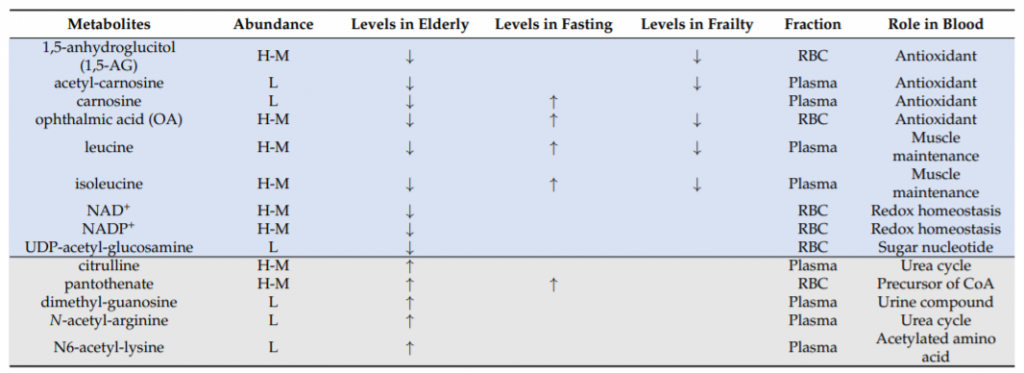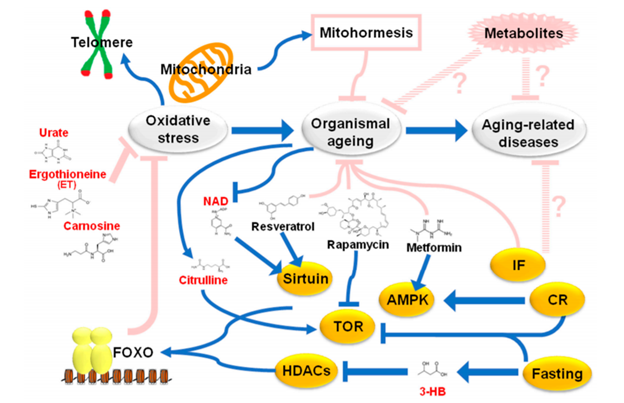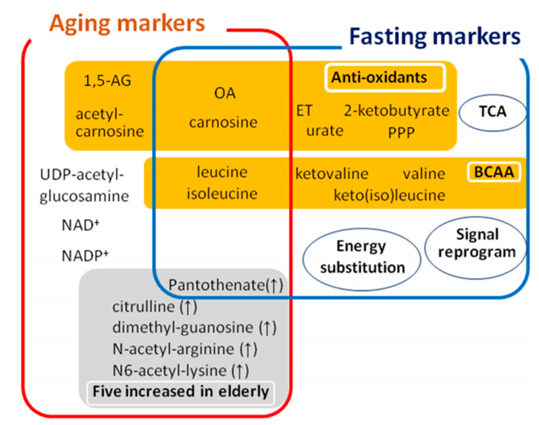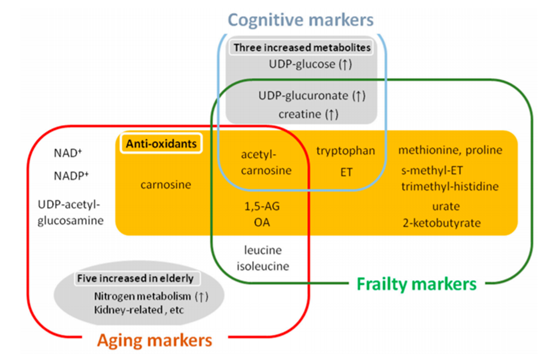Previous research has shown that aging can be combatted through metabolite supplementation in addition to restricting calorie intake, which can be achieved via an altered diet that diminishes daily average calorie intake. Organisms such as flies, fish, mice, and spiders have all displayed a 20% or more increase in lifespan when daily calorie intake is reduced by 20-30%. Furthermore, the consumption of supplements such as resveratrol, rapamycin, and metformin have all been used to combat either obesity, aging, and diabetes. However, we not only have to determine and identify compounds that exert anti-aging effects, but we also need to elucidate the mechanism of action in humans for these candidates.
Research on markers of aging in human blood was explored in a literature review found in the International Journal of Molecular Sciences, and this review was conducted by Kondoh and colleagues in Japan. Metabolites associated with aging and disease were explored by investigating blood metabolites that are present during aging. Various published studies were analyzed, and the investigators of this article identified 14 organic metabolic byproducts that either increase or decrease during aging. Of the 14 identified compounds, nine decreased upon aging, and five increased upon aging. Conclusions from this review suggest that age-related diseases could be targeted with improved clinical intervention and more efficient diagnostics.

Blood Metabolite Markers Overlap in Aging and Fasting

After Kondoh and colleagues analyzed metabolite profiles, only five metabolites were found to increase in concentration during aging. The conversion of toxic ammonia to urea and dimethyl-guanosine, which are compounds found in urine, facilitate the formation of these five metabolites. While they only identified five metabolites that increase during aging, nine blood metabolite markers were found to decrease in elderly adults.
The following list displays the role of 5 metabolites that diminish upon aging: leucine and isoleucine (muscle maintenance), NAD+ and NADP+ (monitoring electron balance within cells), and UDP-acetyl-glucosamine (blood sugar).
Reactive oxygen species (1,5-AG, OA, acetyl-carnosine, and carnosine), which are deleterious oxygen-containing compounds, can be combatted with the other four blood metabolites that deplete with aging. Furthermore, due to antioxidants being part of blood metabolite markers of aging, they propose that oxidative stress could induce aging via physiological stress. Therefore, moderation of aging and age-related diseases could be improved through fasting, which is linked to increases in antioxidant defense.
Caloric restriction, which results from fasting, has been proposed to affect five of the 14 metabolites associated with change upon aging. Of the five metabolites affected by caloric restriction, the following four were associated with a decrease in metabolite concentration upon aging: OA, carnosine, leucine, and isoleucine. The remaining metabolite, pantothenate, was associated with an increase in metabolite concentration upon aging.

Metabolite Blood Markers Overlap In Aging and Frailty
Further analysis of the 14 metabolites and their connection to frailty showed that the concentration of five blood metabolites not only decreased upon aging but also in frailty. This group of metabolites included isoleucine and leucine, which help maintain muscle, in addition to 1,5-AG, OA, and acetyl-carnosine, which serve as antioxidants. Through investigation of blood metabolite markers and analysis of how they overlap between aging and frailty may elucidate potential metabolic targets for supplements used in combatting aging and preventing age-related diseases.

“Interestingly, metabolites affected in frailty largely overlap with metabolites that decrease during aging (acetyl-carnosine, OA, 1,5-AG, isoleucine, and leucine) and compounds that increase during fasting (2-ketobutyrate, OA, isoleucine, leucine, urate, and ET) indicating an intriguing metabolic link between frailty and human aging,” stated the researchers in their article.
Metabolite Blood Markers Provide Insight for Therapeutic Targets During Aging
“As one hint of human aging research, results of whole blood metabolomics help to better understand biological age, especially given the variable nature of aging.” With a greater diversity of factors causing disease in aged individuals, finding common blood metabolite markers predisposing to aging and age-related diseases may provide scientists with therapeutic targets for supplementation.
As research continues on metabolic supplementation, one candidate that is proposed to intervene against human aging is nicotinamide mononucleotide (NMN), a direct precursor to nicotinamide adenine dinucleotide (NAD+). As NAD+ metabolite concentration decreases upon aging, we suggest that utilization of NMN supplementation promotes NAD+ formation, which may ultimately improve the overall healthspan in aged individuals. Improvement of metabolite profiles for healthy aging through supplementation still requires more in-depth metabolomics blood research.